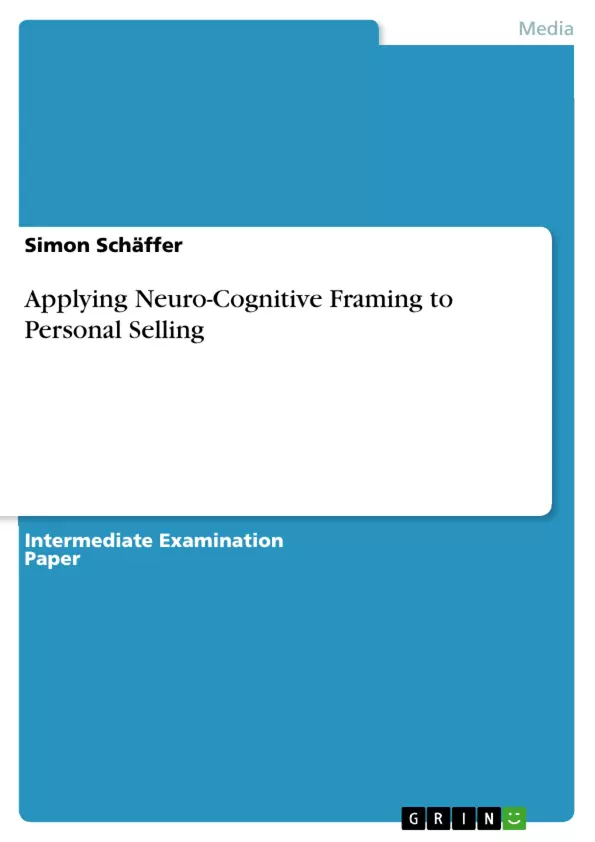In this thesis, I would like to connect Neuro-Cognitive Framing with established marketing frameworks to find out whether Framing may become an integral part of future promotion strategy.
Neuro-Cognitive Framing is a new communication concept developed by linguistic expert Elisabeth Wehling. It suggests that human thinking happens based on interpretative frameworks, called Frames, which are created through individual real-world experience. The concept is assessed and applied on a pre-established personal selling framework to evaluate if Framing is applicable to personal selling whilst improving personal selling efficacy. After comprehensive theoretical assessment, an implementation guide for Framing in personal selling is established and the concept is explored in a qualitative research experiment.
Inhaltsverzeichnis (Table of Contents)
- I. Abstract
- 1. Introduction
- 1.1. Motivation
- 1.2. Objective
- 1.3. Approach
- 1.4. Scope
- 2. Personal Selling
- 2.1. Introduction
- 2.2. Classification
- 2.3. Function and Objectives
- 2.4. The Personal Selling Process
- 2.4.1. Introduction to the Concept
- 2.4.2. 8 Steps
- 2.4.2.1. Prospecting & Qualifying
- 2.4.2.2. Pre-Approach
- 2.4.2.3. Approach
- 2.4.2.4. Need Assessment
- 2.4.2.5. Presentation & Demonstration
- 2.4.2.6. Handling Objections
- 2.4.2.7. Closing
- 2.4.2.8. Follow-Up
- 2.4.3. Implications
- 2.5. Critical Success Factors
- 2.5.1. Market
- 2.5.2. Customer
- 2.5.3. Product
- 2.5.4. Communication
- 2.5.5. Salesperson
- 2.5.6. Summary
- 2.6. Performance Tracking
- 2.7. Challenges of Personal Selling
- 2.8. Summary
- 3. Neuro-Cognitive Framing (E. Wehling)
- 3.1. Introduction
- 3.2. Scientific Background
- 3.3. Theoretical Support in Communication Frameworks
- 3.3.1. Framing & The Mathematical Model of Communication (Shannon & Weaver)
- 3.3.2. Framing & The Four-Sides Model (v. Thun)
- 3.3.3. Implications
- 3.4. Goals
- 3.5. Communication Consequences
- 3.5.1. Frame Negation
- 3.5.2. Frame Repetition
- 3.5.3. Metaphors
- 3.5.4. Communication Channel Selection
- 3.6. Role in Politics
- 3.7. Opportunities of Framing
- 3.8. Challenges of Framing
- 3.9. Ethical Aspects
- 3.10. Summary
- 4. Neuro-Cognitive Framing in Personal Selling
- 4.1. Framing and Personal Selling Objectives
- 4.2. Framing and the Personal Selling Process
- 4.3. Framing and Critical Success Factors
- 4.4. Framing and Performance Tracking
- 4.5. Framing and Personal Selling Challenges
- 4.6. Opportunities
- 4.7. Challenges
- 4.8. Summary
- 5. Implementation Process
- 5.1. Situation Analysis
- 5.2. Frame Development
- 5.3. Medial Realization
- 5.4. Rollout
- 5.5. Controlling
- 5.6. Summary
- 6. Example: Framed Sales Conversation & Market Research
- 6.1. Research Question
- 6.2. Research approach
- 6.3. Sampling
- 6.4. Framing Implementation
- 6.5. Research Results
- 6.6. Critical Evaluation
- 6.7. Summary
- 7. Conclusion & Outlook
- Neuro-Cognitive Framing
- Personal Selling
- Communication Effectiveness
- Frame Development and Implementation
- Qualitative Research Findings
- Chapter 1: Introduction: Introduces the research topic, motivation, objective, approach, and scope of the thesis.
- Chapter 2: Personal Selling: Provides a comprehensive overview of personal selling, including its classification, function, objectives, the personal selling process, critical success factors, performance tracking, and challenges.
- Chapter 3: Neuro-Cognitive Framing (E. Wehling): Discusses the theoretical foundations and practical implications of Neuro-Cognitive Framing, examining its scientific background, theoretical support in communication frameworks, goals, communication consequences, role in politics, opportunities, challenges, ethical aspects, and a summary of the concept.
- Chapter 4: Neuro-Cognitive Framing in Personal Selling: Analyzes the intersection of Neuro-Cognitive Framing and personal selling, exploring how the concept aligns with personal selling objectives, the selling process, critical success factors, performance tracking, challenges, opportunities, and potential challenges.
- Chapter 5: Implementation Process: Outlines a practical implementation process for applying Neuro-Cognitive Framing in personal selling, including steps such as situation analysis, frame development, medial realization, rollout, controlling, and a summary of the process.
- Chapter 6: Example: Framed Sales Conversation & Market Research: Provides a real-world example of implementing Framing in a sales conversation, including a research question, research approach, sampling, framing implementation, research results, critical evaluation, and a summary of the findings.
Zielsetzung und Themenschwerpunkte (Objectives and Key Themes)
The main objective of this thesis is to assess the applicability of Neuro-Cognitive Framing, a communication concept developed by Elizabeth Wehling, to personal selling and to evaluate its potential in improving personal selling efficacy. The research utilizes a pre-established personal selling framework to evaluate the concept and establish an implementation guide for Framing in personal selling.
Zusammenfassung der Kapitel (Chapter Summaries)
Schlüsselwörter (Keywords)
The primary keywords and focus topics of this thesis include: Neuro-Cognitive Framing, personal selling, communication effectiveness, framing implementation, qualitative research, sales process, critical success factors, communication frameworks, and ethical considerations.
- Quote paper
- Simon Schäffer (Author), 2018, Applying Neuro-Cognitive Framing to Personal Selling, Munich, GRIN Verlag, https://www.grin.com/document/1156531



